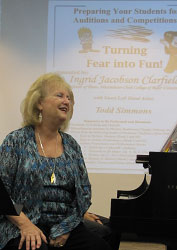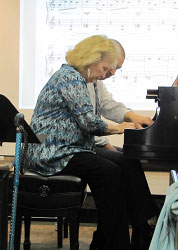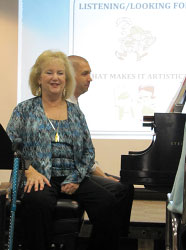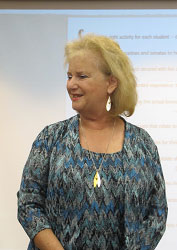Music Educators Association of New Jersey
Serving teachers and students since 1927



On October 16, 2014, the master teacher Ingrid Jacobson Clarfield, Professor of Piano at Westminster Choir College of Rider University, presented a comprehensive program entitled "Turning Fear into Fun: Preparing Your Students for Auditions and Competitions."

Ms Clarfield, an MEA member, captivated her audience with her knowledge, her enthusiasm, and humor. Her rich history as teacher, lecturer, pianist, and author is detailed at her website:http://www.ingridclarfield.com/home.asp
Ruth Kotik, Hostess, when asked to abbreviate her introductory remarks by the eminent speaker, reluctantly closed by saying that, even thirty years ago, the students of Ingrid Clarfield were consistently outstanding in competitions. We wondered, "How does she do it?" For thirty years, in over 100 cities, teachers have been attending her lectures, master classes, and courses, and for twenty-five years, have been buying her publications, (now up to 19), to learn her techniques.

"Performing," she began, is "the greatest way to motivate students." But giving only one or two performances in a school year may cause more anxiety than excitement. Several auditions and competitions throughout the year can bring the challenges into a healthier perspective. If one performance is disappointing, there will soon be another opportunity. Then, with the assistance of Todd Simmons, her Guest Left Hand Artist and collaborator in demonstrating, and Lisa Gonzalez, MEA Power Point pilot, she began to describe the preparation of students for these events.
First, she emphasized, not every competition is "right" for every student; the teacher's guidance is needed. In New Jersey, the choices run from highly competitive to elementary achievement. The costs vary, some requiring purchasing concert tickets in addition to registration fees. Some are not good values. Ms Clarfield displayed a sample chart listing details of various competitions so that they might be compared. Factors included: dates, locations, performance limits, selection requirements, and concert obligations of contest winners and their families. Every technicality, for example, age requirements and cut off dates, must be scrutinized.
Then, she got to the core of her presentation: "preparing the student for all aspects of the entire experience." This begins in earnest at least two weeks before the audition. There are rehearsals at the lesson of preliminaries: greeting the judges, handing the music to the judges, (music in order, pages marked), adjusting the bench height and making sure it is centered, checking the pedals and knowing how to adjust the pedal box if needed. The student must be able to recite the titles and composers of the pieces. The student should ask, "May I warm up, please?"
At this point, Ms Clarfield discussed this audition warm up in great detail to demonstrate how the little warm up could be the all-important step to help the student feel ready to do his/her best. These warm up drills are rehearsed at the lesson and not left to chance. They are individually designed and specifically related to the chosen repertoire. Instead of taking excerpts directly from the selections, the warm up would be derived from the selection, employing melodic patterns, scale segments, chord or dyad patterns, and related rhythms and/or articulation. For example, Mozart's Fantasie in D minor might be preceded by a right hand playing a portato D minor scale, and next, the left hand with sustained low chord tone, and carefully voiced repeated, detached dyads above. Debussy's Golliwog's Cakewalk would be preceded by an E-flat major scale played with the same rhythm and articulation as the lively opening bars of the piece. A warm up for the Molto allegro of Mozart's Sonata in C Minor, K 457 would include robust octaves in C minor, followed by a singing E-flat major scale.
One brilliant hint was to end the warm up with a sequence related to the first selection in the audition program. For example, when the audition pieces were Khachaturian's Andantino and Burgmüller's Arabesque, the warm up would include right hand playing a five note scale slowly with singing tones, and then speedily in sixteenth notes, a left hand singing five key scale, left hand chords, all in A minor, then moving to the right hand "singing" legato tetrachords using flats of C minor, and next, the left hand in gentle thirds. This was the perfect segue to the Andantino.

She advises: "Make the judge notice your outstanding openings and fabulous finishes." Opening gestures are critical. The arm choreography and posture, the spine, the angle of the head must relate to the piece to help the performer establish the mood. When one hand begins the piece, the second hand should make a choreographed entrance. Bold but controlled arm movements, raising and then lowering an arm in an arc can help in timing and in preparing needed weight for good tone, not only when there is an entrance but throughout a piece, when sustained notes must get full value. Similarly, endings must "match the mood of the piece," whether pensive or energetic. Say no to knee slapping or jumping up!
Before a performance begins, the student should think of a model measure that will help start at the best tempo. This, too, can be prepared at the lessons. All of this preparation certainly builds confidence in any student. But Ingrid had more to add.

She asked, "What do judges look for in a performance? What makes it artistic?" The audience responded with many criteria, which were accepted. But Ms Clarfield added that a sense of style was essential. From this conviction, she created her 3 book series, Keys to Stylistic Mastery. Composer Dennis Alexander collaborated with her, composing pieces in the style of each period, even at the late-elementary level. Judges also listen for color and orchestration. But today, some students have never heard a symphony orchestra, even on YouTube. The teacher must guide them. And if they have difficulty interpreting a melody, let them create a libretto for it to make it more meaningful.

Finally, Ms Clarfield declared, "evaluations can be fun." In the student assignment book, there should be entries of what is already good in addition to the new assignment. Video tapings also help student and teacher reach performance goals. Self-evaluation is encouraged. She recommended that students prepare written evaluations of performances by themselves and by their peers, making two columns, one with positive comments and the other with constructive criticisms. Then in preparation for an audition or performance, the student will write three essential elements to remember on an index card to be taken to the audition.
And, speaking of memory, Ms Clarfield touched on that too. She suggested that theory should incorporated in the study of pieces, and that the greatest worries arise when there is a return of material that is altered or transposed. Various sonatas were cited. Identify the two passages, and compare them, looking at the pivotal point where the departure from the original occurs. Then, recite the names of the notes to become fully aware of the similarities and differences.
The audience left better equipped to prepare their students for auditions and competitions, but also eager to hear Ms Clarfield again, as she has so much that she is willing to share.

Bertha Mandel, Writer
Ruth Kotik, Hostess